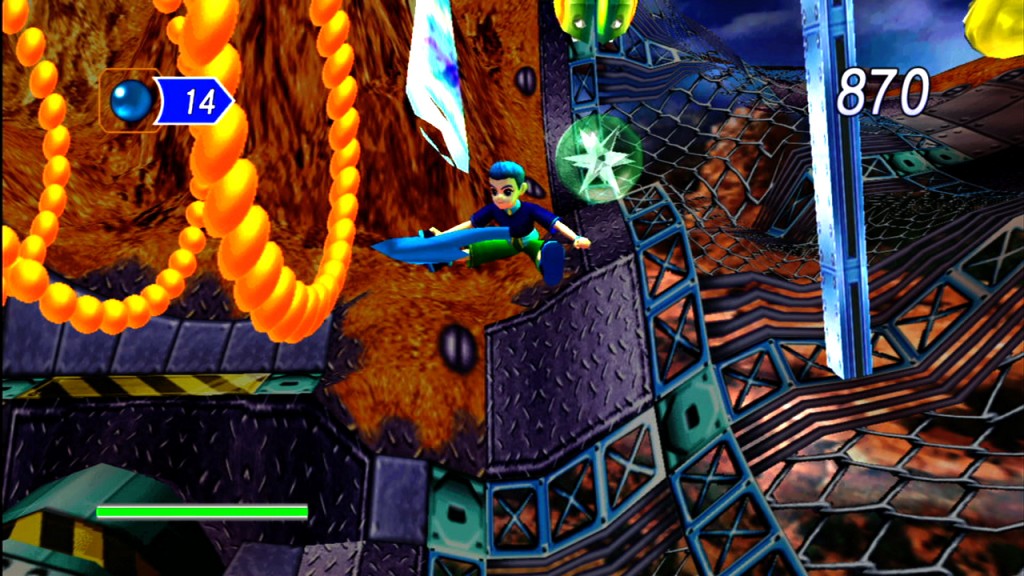Much like listening in on someone’s dreams, NiGHTS into Dreams… is endlessly fascinating to those experiencing it but incomprehensible to anyone listening in.
First released on the Sega Saturn 16 years ago, NiGHTS (hencforth just Nights for the sake of copy editors everywhere) was Sonic Team’s big push for the console, an ambitious game that aimed to accurately convey the feeling of flight just as their namesake aimed to capture the sensation of speed. This re-release comes in two flavors; a no frills rendering of the original as seen in 1996 and an HD upscale of the 2008 Japan only PS2 remake.
Both versions of the game played identically. Players take the role of Nights, a genderless creature resembling a flying jester who has been imprisoned by the ruler of Nightmare. Once freed from his prison by one of the game’s two human playable characters, Nights circles around one of four predetermined routes around the course, collecting 20 blue orbs that it must deposit in a cage on a set place along the map. All the while players are flying through rings and performing tricks in rapid succession through the game’s colorful backdrops to to create links that will increase your score. Nights rinses and repeat onto to the next three routes before facing a boss at the end of the level because hey, 1996.
Learning to fly in Nights is awkward. There is a real lack of any direction in coming to grips with the game’s mechanics which aren’t really communicated to you at all. There’s an obligatory how to play buried in the the standard arcade menus, but that doesn’t give any meaningful insight into the game’s intricacies. Learning on the game’s time limit is rough, and it feels like a missed opportunity to not include footage of speedruns or high ranking runs that could both show and tell. It’s not like the game is so exceedingly complex that the remain mechanics couldn’t be taught to players.
This is exasperated by the level design, which are largely dependent on trial and error to find optimal paths and and layouts. Boss fights at the end of each level further complicate things, which are puzzles that are needlessly frustrating on the tight time limit the game gives you and annoyingly simplistic after you’ve figured it out. The first pass almost universally ends with failure, and a lack of any checkpoints sends you back to the very beginning of the level.
Nights is a step away from Sonic the Hedgehog, but it’s still indebted to capturing speed and fluidity in motion which doesn’t happen nearly enough for how genuinely impressive it feels when it works out.
Most times though, Nights feels every bit of its 16 years. The polish applied pushes the game’s vibrant and appropriately dream like art style to the forefront, but there are still lingering remnants of its place in history, Nights is a good example of the stumbling caused by the early experiments of the possibilities of 3D in games. The game’s flying segments are tightly locked to one plane, with the appearance of the rest of the world lying within the background. Rings and collectables will appear to be on the same plain when they aren’t, and reaching for these will result in broken streaks and combos. The short draw distance and pop in doesn’t really help and further enforces the game’s trial and error aspects. We’ll just ignore the laughable on foot sections that kick off every level which where bad then and are bad now. Nights feels stuck between dimensions.
Regardless of how the game has aged, SEGA continues its recent string of treating their rereleases right. Concept art, sound tests and a brief documentary on the game are nice features that place the game into the context and historical prospective that does it a lot of favors. Though the real surprise is that seemingly as an early holiday present, the game also includes the Christmas Nights content, a festively reskinned version of the Spring Valley level of that further pushes the charming warm fuzzies button that Nights can press at its best.
I suspect a lot of the goodwill that has built up around Nights over the years that has canonized Nights as an important game came from lingering loyalty to Genesis era SEGA, as they shifted fronts from battling Nintendo to the upstart PlayStation. With a fairly limited library Saturn owners likely spent a lot of time with NiGHTS, and the small amount of levels gave people plenty of time to learn it like the back of their hands.
The moments of clarity in Nights are closely linked to the feeling of flight, which occasionally lets the game soar over its age and issues. That core mechanic of flight is worth revisiting (though ideally better than the misguided sequel on the Wii), with all of the imagination present matched with a more modern understanding of game design.
As a museum piece Nights is reverently treated, but you might not really want to touch it.



